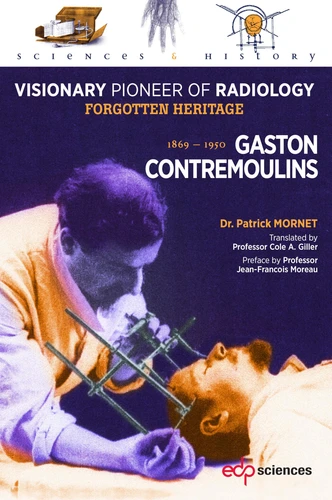Gaston Contremoulins, 1869 - 1950. Visionary Pioneer of Radiology - Forgotten heritage
Par :Formats :
Disponible dans votre compte client Decitre ou Furet du Nord dès validation de votre commande. Le format PDF est :
- Compatible avec une lecture sur My Vivlio (smartphone, tablette, ordinateur)
- Compatible avec une lecture sur liseuses Vivlio
- Pour les liseuses autres que Vivlio, vous devez utiliser le logiciel Adobe Digital Edition. Non compatible avec la lecture sur les liseuses Kindle, Remarkable et Sony
 , qui est-ce ?
, qui est-ce ?Notre partenaire de plateforme de lecture numérique où vous retrouverez l'ensemble de vos ebooks gratuitement
Pour en savoir plus sur nos ebooks, consultez notre aide en ligne ici
- Nombre de pages192
- FormatPDF
- ISBN978-2-7598-2230-0
- EAN9782759822300
- Date de parution05/04/2019
- Protection num.Digital Watermarking
- Taille16 Mo
- ÉditeurEDP Sciences
Résumé
How could a self-taught scholar of the calibre of Gaston Contremoulins be forgotten?
Driven by his fascination with photography and the discovery of X-rays by Roentgen in 1897, he was the first to invent a device capable of locating intracranial foreign bodies. He thus anticipated the development of stereotaxis, so crucial to modern medicine half a century later. He was recognized and appointed director of the main radiology department of Necker Hospital in Paris.
Yet he was not a doctor! His design of a complete radiological technology for three-dimensional visualization was a work of genius, foreshadowing the principles of the CT scanner. His interest in orthopedic problems led him to develop sophisticated uses of radiographic images to manufacture prostheses and fusion instruments, thus founding a field he called « radiosurgery ». He was a pioneer in radiation protection measures, fighting the widespread and erroneous belief that X-rays were harmless! Although he was vigorously defended by the Academy of Science and the great surgeons of the Paris Hospital, his enemies managed to erase his name and work from the historical archives. This work by Patrick Mornet places Contremoulins in his rightful position in the history of radiology: at the front!
Yet he was not a doctor! His design of a complete radiological technology for three-dimensional visualization was a work of genius, foreshadowing the principles of the CT scanner. His interest in orthopedic problems led him to develop sophisticated uses of radiographic images to manufacture prostheses and fusion instruments, thus founding a field he called « radiosurgery ». He was a pioneer in radiation protection measures, fighting the widespread and erroneous belief that X-rays were harmless! Although he was vigorously defended by the Academy of Science and the great surgeons of the Paris Hospital, his enemies managed to erase his name and work from the historical archives. This work by Patrick Mornet places Contremoulins in his rightful position in the history of radiology: at the front!
How could a self-taught scholar of the calibre of Gaston Contremoulins be forgotten?
Driven by his fascination with photography and the discovery of X-rays by Roentgen in 1897, he was the first to invent a device capable of locating intracranial foreign bodies. He thus anticipated the development of stereotaxis, so crucial to modern medicine half a century later. He was recognized and appointed director of the main radiology department of Necker Hospital in Paris.
Yet he was not a doctor! His design of a complete radiological technology for three-dimensional visualization was a work of genius, foreshadowing the principles of the CT scanner. His interest in orthopedic problems led him to develop sophisticated uses of radiographic images to manufacture prostheses and fusion instruments, thus founding a field he called « radiosurgery ». He was a pioneer in radiation protection measures, fighting the widespread and erroneous belief that X-rays were harmless! Although he was vigorously defended by the Academy of Science and the great surgeons of the Paris Hospital, his enemies managed to erase his name and work from the historical archives. This work by Patrick Mornet places Contremoulins in his rightful position in the history of radiology: at the front!
Yet he was not a doctor! His design of a complete radiological technology for three-dimensional visualization was a work of genius, foreshadowing the principles of the CT scanner. His interest in orthopedic problems led him to develop sophisticated uses of radiographic images to manufacture prostheses and fusion instruments, thus founding a field he called « radiosurgery ». He was a pioneer in radiation protection measures, fighting the widespread and erroneous belief that X-rays were harmless! Although he was vigorously defended by the Academy of Science and the great surgeons of the Paris Hospital, his enemies managed to erase his name and work from the historical archives. This work by Patrick Mornet places Contremoulins in his rightful position in the history of radiology: at the front!





